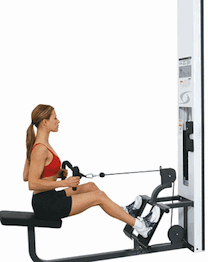Thanks for the reply, DK. Your info is always helpful. I’ll try the rows standing up. There is equipment at the gym I go to that I can adjust and use for that. I’ll also check out your assessment for body mobility.
Oh, and thanks for the info in your article about the dips and related stress on the shoulders. I use to do these, but stopped when my shoulder bothered me. My intention was to return to doing dips after my shoulder felt better, but I now I know better.
Joe
Joe –
Happy tp help. Glad you discovered the down side to the dips. This is one of the reasons I started Fusion – to help people train hard but train smart.
DK,
I just wanted to make sure I understood what you meant by a fexed posture of the lower back if one’s hips are tight when doing a low row. Flexed as in rounded out away from the front of your body or flexed as in rounded in towards your the front of your body? I try to keep a neutral spine similar to sitting on a chair with no back, and believe I am fairly flexible in the hips (what is a good test for hip flexibility?).
I don’t have a suspension trainer and do seated rows at the gym using strap handles so I can postion and rotate my hands as I perform the row to minimize stress on my shoulders. I used to do pull ups, but currently cannot due to a shoulder injury. And I don’t care for doing the rows on a machine like Nautalis. Is there a better option or is the low row OK if I can determine I have adequate hip flexibility?
Thanks,
Joe
Joe –
A flexed lower back means that it is rounded away from the front of your body in a similar way to what happens when you bend forward to touch your toes. This happens in the low row because the either the hip lacks mobility or the posterior musculature – hamstrings, gasctrocs, gluteals – are tight. So when you sit down with the feet out in front of you, it forces your lower back to flex; sort of tugs it into a rounded position. Bending the knees slightly, as in the image in the article, sometimes frees up the tension in the legs to allow for a more neutral spine.
I don’t suggest the drill because there are a number of other ways to train your upper body and trunk with lower risk of injury and with a greater transfer to everyday life, sport, hobbies. So, you could do the same movement – row – but in standing. This makes a lot of muscles work – so it increases the metabolic demand – and it’s a lot safer. You won’t be able to pull as much weight as in the sitting position since you no longer have the counter force of your feet but that’s actually a good thing.
And to answer your question about hip mobility, have you taken our assessment? If not, there are some tests in it for lower and upper body mobility.
Thanks for commenting Joe.
Omar –
Yes, the STAMINA series is designed to do exactly that. You manipulate load and speed to achieve more work per unit time.
Hi DK-
I’m confused. You just described “power” (work per unit time). I was asking whether the STAMINA element improves “efficiency” (work per unit energy consumed). If so, then with STAMINA training I might loose less weight on the hike.That would appeal to me.
Sorry, I’m probably stretching the blog/comments beyond it’s intended function and not so clearly at that….Thanks again for the great article.
Yep, you’re right. Power. My bad.
STAMINA is the ability to resist fatigue – so yes, you’re performing more work using less energy overall; less energy required to get the work done (which is what I meant when I mistakenly used the POWER reference).
Hope that helps.
Awesome article DK. Question: From your discription, It seems like there is a tradeoff between body-building and increasing-metabolism. Did I read you right? In laymans terms, what distinguishes a body-building drill from a metabolic-demand drill? Why did you single out the shoulder-focus drills as the body-building drills?
I actually have a reason for wanting to build up my body (or maybe just “gain weight”). I’ll be going on an adventure in August which will be very physically demanding and from which I’ll likely return smaller than I already am (which is already pretty small)….I free the need to increase my reserve stores! So articles about safe ways to gain mass are very much of interest….THANKS!
Hi Omar –
Thanks for commenting and for your questions.
“Body Building” type drills are almost always body part oriented or focused. So the shoulder drills, for example, don’t require much from the rest of the body. The focus is solely the shoulder. Yes, you have to stabilize to a degree but the work load is low (now, if you did those drills Flamingo style, different story). Compare that to a Fusion 45 Degree Lunge and Lift – much greater use the body and multiple muscles so the energy demand is a lot higher.
For your trip, IMHO, you likely don’t need mass. You need STAMINA (strength + endurance) so the Stamina series would be helpful. I would also bump up your intake of fats and protein too. Then about seven days before you leave, you will want to go into a recovery phase – low energy expenditures, rest, allowing your body to super-compensate.
Thanks DK! You are absolutely right that having more stamina would help me perform better. Adding mass would not. My starting assumption is that I won’t be able to consume enough calories on the trip and that mass would be lost. Do the Stamina Elements generally improve efficiency (ie; more work done with less energy expenditure)?
BTW, the Fusion 45 Degree Lunge and Lift is a great drill. Thanks again, oz


